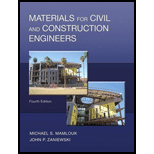
Two batches of concrete cylinders were made with and without a calcium chloride (CaCl2) accelerator admixture. Five cylinders were made of each batch and submerged in water for different times before testing for compressive strength and the results are shown in Table P6.36.

It is required to do the following:
a. Using an Excel sheet, plot the relationship between curing time and compressive strength of the two mixes on the same graph. Label all axes and curves.
b. Comment on the effect of the accelerator on the compressive strength of PCC at early and late ages.
Want to see the full answer?
Check out a sample textbook solution
Chapter 6 Solutions
Materials for Civil and Construction Engineers (4th Edition)
Additional Engineering Textbook Solutions
Modern Database Management
Java How to Program, Early Objects (11th Edition) (Deitel: How to Program)
Starting Out with Python (4th Edition)
Degarmo's Materials And Processes In Manufacturing
Starting Out with C++ from Control Structures to Objects (9th Edition)
Computer Science: An Overview (13th Edition) (What's New in Computer Science)
- For given distributed loads, see figures below, determine resultant and moments around load ends (points A and B). Assume p = 2kN/m.arrow_forwardA permeability test apparatus of diameter 82.5 mm contains a column of fine sand 460 mm long. When water flows through it under a constant head at a rate of 191 cm3/minute, the loss of head between two points 250 mm apart is 380 mm. Calculate the coefficient of permeability of the fine sand. If falling head test is made on the same sample using a standpipe of diameter of 30 mm, in what time will the water level in standpipe fall from 1560 mm to 1066 mm above outflow level.arrow_forwardComputation must be completeFor the given cantilever beam shown in the figure below,a. Draw the shear and moment diagram using service loads.b. Determine the critical design moment using Working Stress Design (Ma) load combinations.c. Draw the shear and moment diagram using factored loads.d. Determine the critical design moment using Strength Design (Mu) load combinations, use NSCP2015.e. For the given cross-section of the beam, give the reason why the reinforcement is at the topportion of the beam section?arrow_forward
- LAB: FORCE AND FORCE-RELATED VARIABLES ASSIGNMENT INSTRUCTIONS INSTRUCTIONS Lab assignments are intended to give you some ‘hands on' experience in applying the concepts introduced in the course text. They are designed to get you out of your classroom or office and develop the skills of designing experiments and collecting data, and then performing calculations, evaluating the results, and communicating your findings. Labs are more than just number crunching - they are about reflecting on what is both practical and technically sound engineering problem-solving. For each problem below, address the scenario presented and develop engineering solutions. Communicate your results using drawings, pictures, and discussion, supported by calculations developed using the Microsoft Equation Editor or similar tool. Submit your lab report in a single pdf file uploaded to the location provided in Canvas before the due date/time indicated. Each problem should be treated as a micro-report with a problem…arrow_forwardHow can a construction estimator gain experience to better judge appropriate contingency amounts?arrow_forwardWhat are the potential risks and rewards of including a higher or lower contingency amount in a construction estimate?arrow_forward
- Draw moment and shear diagramsarrow_forwardFIND THE INTERNAL MISSING ANGLES AND MISSING SIDESOF A 90° RIGHT TRIANGLE WITH A HEIGHT OF 96 AND A BASE OF 48.DRAW A PROPORTIONAL SKETCH OF THE TRIANGLE, IDENTIFY GIVEN INFORMATIONAND LABEL MISSING INFORMATION. WHAT IS AREA TO THE NEAREST SQ. FT.?arrow_forward2,789.10 FEET = HOW MANY METERS (M)?arrow_forward
 Materials Science And Engineering PropertiesCivil EngineeringISBN:9781111988609Author:Charles GilmorePublisher:Cengage Learning
Materials Science And Engineering PropertiesCivil EngineeringISBN:9781111988609Author:Charles GilmorePublisher:Cengage Learning Traffic and Highway EngineeringCivil EngineeringISBN:9781305156241Author:Garber, Nicholas J.Publisher:Cengage Learning
Traffic and Highway EngineeringCivil EngineeringISBN:9781305156241Author:Garber, Nicholas J.Publisher:Cengage Learning Fundamentals Of Construction EstimatingCivil EngineeringISBN:9781337399395Author:Pratt, David J.Publisher:Cengage,
Fundamentals Of Construction EstimatingCivil EngineeringISBN:9781337399395Author:Pratt, David J.Publisher:Cengage, Fundamentals of Geotechnical Engineering (MindTap...Civil EngineeringISBN:9781305635180Author:Braja M. Das, Nagaratnam SivakuganPublisher:Cengage Learning
Fundamentals of Geotechnical Engineering (MindTap...Civil EngineeringISBN:9781305635180Author:Braja M. Das, Nagaratnam SivakuganPublisher:Cengage Learning Construction Materials, Methods and Techniques (M...Civil EngineeringISBN:9781305086272Author:William P. Spence, Eva KultermannPublisher:Cengage Learning
Construction Materials, Methods and Techniques (M...Civil EngineeringISBN:9781305086272Author:William P. Spence, Eva KultermannPublisher:Cengage Learning Steel Design (Activate Learning with these NEW ti...Civil EngineeringISBN:9781337094740Author:Segui, William T.Publisher:Cengage Learning
Steel Design (Activate Learning with these NEW ti...Civil EngineeringISBN:9781337094740Author:Segui, William T.Publisher:Cengage Learning





